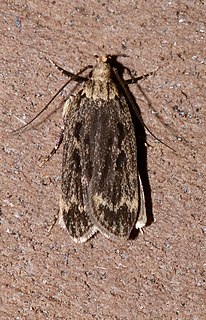
Semioscopis avellanella is a species of moth of the family Depressariidae. It is found in most of Europe east to the eastern parts of the Palearctic realm.

Ichneutica scutata is a moth of the family Noctuidae. It is endemic to New Zealand. This species can be found in the southern parts of the North Island as well as the eastern parts of the South Island. It is similar in appearance to I. insignis and I. skelloni but can be distinguished as I. scutata is much paler in appearance. It is likely this species inhabits lowland tussock grasslands as well as coastal dunes although it is not common in inland tussock grasslands. The larvae feed on a variety of herbaceous plants such as Plantago and Convolvulus species, Plagianthus divaricatus. It pupates on soil near its host plants. The adults are on the wing from late March to July.
Dichomeris explicata is a moth in the family Gelechiidae. It was described by Edward Meyrick in 1929. It is found on New Hanover Island in the Bismarck Archipelago of Papua New Guinea.
Bagdadia cymoptila is a moth in the family Gelechiidae. It was described by Edward Meyrick in 1929. It is found in southern India.
Recurvaria vestigata is a moth of the family Gelechiidae first described by Edward Meyrick in 1929. It is found in North America, where it has been recorded from Ontario.
Symmetrischema fercularia is a moth in the family Gelechiidae. It was described by Edward Meyrick in 1929. It is found in North America, where it has been recorded Texas.
Thiotricha amphixysta is a moth of the family Gelechiidae. It was described by Edward Meyrick in 1929. It is found in Assam, India.
Thiotricha termanthes is a moth of the family Gelechiidae. It was described by Edward Meyrick in 1929. It is found in Assam, India.
Thiotricha hexanesa is a moth of the family Gelechiidae. It was described by Edward Meyrick in 1929. It is found in Sri Lanka.
Ischnodoris is a moth genus in the subfamily Autostichinae.
Ischnodoris sigalota is a moth in the family Autostichidae. It was described by Edward Meyrick in 1911. It is found in Sri Lanka.
Glyphidocera lophandra is a moth in the family Autostichidae. It was described by Edward Meyrick in 1929. It is found in Brazil and Peru.
Parelliptis sporochlora is a moth in the family Lecithoceridae. It was described by Edward Meyrick in 1929. It is found in Sri Lanka.
Lecithocera carcinopsis is a moth in the family Lecithoceridae. It was described by Edward Meyrick in 1929. It is found in southern India.
Lecithocera phratriastis is a moth in the family Lecithoceridae. It was described by Edward Meyrick in 1929. It is found in Sri Lanka.
Lecithocera stomobapta is a moth in the family Lecithoceridae. It was described by Edward Meyrick in 1929. It is found in southern India.
Cophomantella pumicata is a moth in the family Lecithoceridae. It was described by Edward Meyrick in 1929. It is known from Mumbai, India.

Martyringa xeraula, the Himalayan grain moth, is a moth in the family Lecithoceridae. It was described by Edward Meyrick in 1910. It is found in India (Assam), western China, Japan and North America, where it has been recorded from Louisiana, Texas and from Florida to South Carolina.
Imma synconista is a moth in the family Immidae. It was described by Edward Meyrick in 1918. It is found in Kanara, India.

Ichneutica paraxysta is a moth of the family Noctuidae. It is endemic to New Zealand. This species is very similar in appearance to its close relative I. acontistis but as the range of the two species do not overlap this is unlikely to cause confusion. I. paraxysta is only found in the North Island at the subalpine zones in the Mount Taranaki region and at Mount Ruapehu. It prefers tussock grassland and shrubland habitat. The life history of this species is unknown as are the host species of its larvae however it has been hypothesised that the larval host plants are species in the genera of Poa and Festuca.



